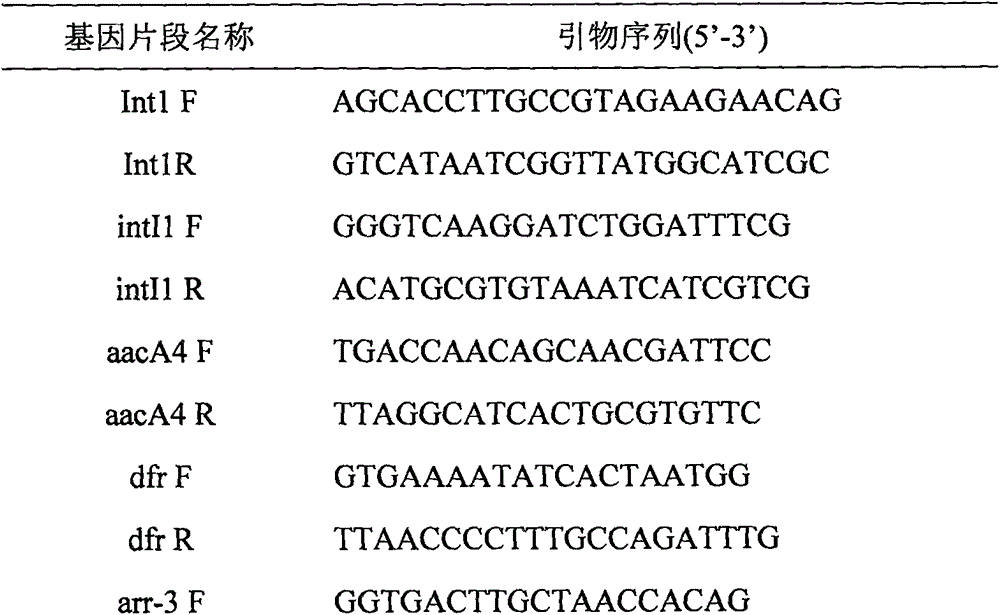Novel integron In1289 containing multiple drug-resistant gene cassettes
An integron, e.colijm109 technology, applied in genetic engineering, plant genetic improvement, microorganism-based methods, etc., can solve problems such as life-threatening, hospital distress, and threat to patient health and safety, to prevent outbreaks and reduce selection. effect of stress
- Summary
- Abstract
- Description
- Claims
- Application Information
AI Technical Summary
Problems solved by technology
Method used
Image
Examples
Embodiment 1
[0027] Example 1 Identification of integron In1289
[0028] 1. Isolation and identification of EC7328 strain
[0029] 1.1 Material
[0030] Bacterial susceptibility card: AST-GN13 from bioMerieux, France. AST-GN13 drug sensitivity types are: amikacin, ampicillin, ampicillin / sulbactam, aztreonam, cefazolin, cefepime, cefotetan, ceftazidine, ceftriaxone, ciproxa Star, ertapenem, gentamicin, imipenem, levofloxacin, nitrofurantoin, piperacillin / tazobactam, tobramycin, SMZ.
[0031] Supplement drug sensitive paper (drug sensitive plate agar diffusion test): The paper comes from Oxoid, UK, with compound trimethoprim (30μg), chloramphenicol (30μg) and rifampicin (5μg).
[0032] 1.2 method
[0033] Apparatus identification: Transplant the strains with positive sputum culture from ICU patients of Taizhou Municipal Hospital to blood plate for isolation and culture (with 5% CO at 35℃) 2 Incubate in an incubator for 16-18h), and then put the separated pure bacteria on the VITEK 2 for bacterial ide...
Embodiment 2
[0055] Example 2 Plasmid transduction experiment to study the function of integron In1289
[0056] 1. Method
[0057] (1) The donor bacteria is the EC7328 strain and the recipient bacteria is E.coli J53 Az R (Resistant to sodium azide). The donor bacteria and recipient bacteria were respectively inoculated on LB plates and cultured overnight at 35°C. A single colony was picked and inoculated into 4 mL of LB broth, and cultured in shaking at 220 r / min at 37°C to the logarithmic growth phase. Take 0.5 mL of donor and recipient bacteria in 4 mL of LB broth, and culture them overnight at 37°C. The zygote was screened with tryptic soy agar (TSA) plates, which contained sodium azide (300mg / L) and amifloxacin (0.06mg / L). Incubate at 35°C for 18-24h. The plasmid of the drug-resistant strain was extracted (the steps were the same as in Example 1), and the sequence of the integron In1289 was detected by PCR.
[0058] The primers for amplifying the sequence of the integron In1289 are shown...
Embodiment 3
[0070] Example 3 Gene recombination experiments to study the function of integron In1289
[0071] 1. Method
[0072] (1) Connect the PCR product (nucleotide sequence SEQ ID NO. 1) in Example 2 to the pMD19-T vector, and add the ligation product to 100 μL of E. coli JM109 for transformation, and then transform it with IPTG, x- Cultivate on gal and Amp plates, extract plasmids from IPTG, x-gal, and Amp resistant strains for sequencing (the steps are the same as in Example 1), and detect whether the integrator In1289 is inserted into the genome. Then the integron In1289 sequence was cloned into the pET32a vector, and the insertion site of the integron was at the BamHI restriction site on the pET32a vector, and prepared according to conventional methods to obtain a pET32a recombinant plasmid containing the integron In1289 sequence. The recombinant plasmid was transformed into competent E.coli JM109 cells.
[0073] (2) Test the resistance of successfully constructed clones
[0074] Using...
PUM
 Login to View More
Login to View More Abstract
Description
Claims
Application Information
 Login to View More
Login to View More - R&D
- Intellectual Property
- Life Sciences
- Materials
- Tech Scout
- Unparalleled Data Quality
- Higher Quality Content
- 60% Fewer Hallucinations
Browse by: Latest US Patents, China's latest patents, Technical Efficacy Thesaurus, Application Domain, Technology Topic, Popular Technical Reports.
© 2025 PatSnap. All rights reserved.Legal|Privacy policy|Modern Slavery Act Transparency Statement|Sitemap|About US| Contact US: help@patsnap.com



